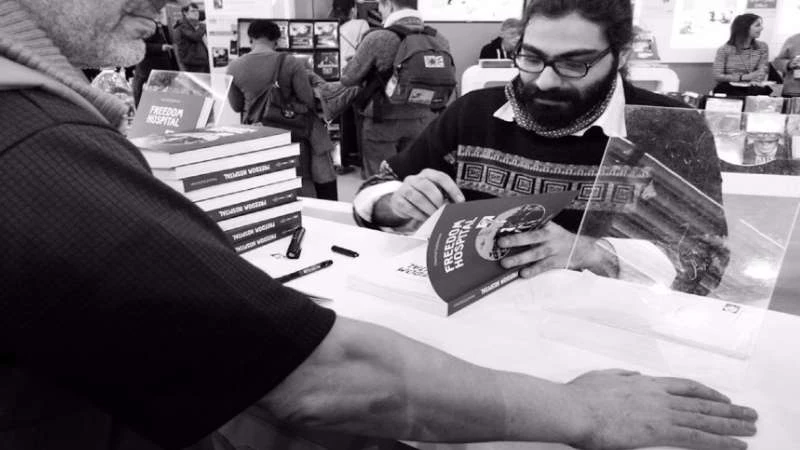Sulaiman fled the Assad regime’s violent crackdown on peaceful protesters in 2011, going first to Egypt and then to Paris, France, where he was able to build his life as an artist, far removed from the totalitarian repression and compulsory military service being faced by young pacifists like himself in his homeland.
In 2014, he won the young talent award from the Culture Resource, an Arab cultural NGO for young artists and writers, along with a writing scholarship for his comic book, Freedom Hospital, which depicted the beginnings of the Syrian revolution.
The “Freedom Hospital” story has since evolved into a graphic novel that illustrates the ongoing horrors of the war in Syria and the people living through it.
Sulaiman dedicated his novel to his best friend, Hassam Kuhayat, who was tortured to death in Syria.
Although real life super heroes have abounded in the years since the revolution began, the graphic artist/author says that the hospital itself is the hero of his book.
"Freedom Hospital" tells the story of a small, illegal clinic in rural Syria. A chain-smoking peace activist named Yasmine runs the clinic where she takes care of wounded rebels, a true act of heroism since the Assad regime declared in 2011 that it was against the law to treat wounded members of the Syrian opposition.
Sulaiman’s novel contains a plethora of diverse characters — Alawites and Kurds, Salafists and Muslim brothers, young revolutionaries, western activists and both opponents and supporters of Assad.
The common denominator for all of them is the hospital where they all meet — making the space a scaled down mirror of the larger conflict that has engulfed Syria.
In a recent interview Sulaiman told Deutsche Welle’s (DW) Stefan Dege why he believes that a graphic novel is the ideal format for communicating the story of the Syrian tragedy.
“Graphic novels lend themselves well to looking at foreign cultures,” he told DW. “Films and documentaries are much more elaborate and costly.
“A graphic novel consists of pictures and texts while enabling the artists to express their own personal style. In this book, I wanted to summarize the experiences I had during the Arab Spring, without knowing how people would react.”
Sulaiman told DW that his target audience was mainly people wanting to know more about what was happening in Syria, as well as those interested in the Middle East, geopolitics and Arab culture.
One of the most common descriptions of what started out as a simple uprising of the Syrian people against a brutal regime is that it is complicated and Sulaiman says that is also reflected in his book.
“Even for me, it’s hard to grasp,” he told DW. “There are so many different groups, different conditions and zones of influence in the cities. In some places, radical Muslims have won the upper hand, elsewhere it’s the regime or the Free Syrian Army or some other militia.
“No situation resembles the next. Who can make sense of this? My book reflects that confusion. That’s why it doesn’t tell the story of a single person, but rather shows what’s happening in Syria.”
When asked why he had dedicated the book to Kuhayat, Sulaiman said, “Hassam was my very best friend. Like me, he studied architecture.
“Together, we joined the revolution and participated in demonstrations. When he wanted to go abroad in order to continue his studies he was arrested; one week later, he was tortured to death.”
When asked if recent reports about torture and executions in Syrian jails were true Sulaiman said; “Everybody knows what this regime is capable of doing, including people who favor Assad. And everybody knows what’s happening in Syrian jails.
“Of course the regime denies all these charges. But do you remember the photographs by Caesar who took pictures of torture victims in a military hospital and then smuggled them out of the country?
“After he published them in 2013, many Syrians looked through them in order to identify missing family members and friends. I discovered a good friend. He was arrested one and a half years beforehand and then tortured to death."
When asked about the possibility of refugees going home Sulaiman answered; “Nobody can return there now. What awaits me there in the best possible case is military service. You’ll die at the front. More likely is that I would disappear in a prison for a long time.”
Sulaiman also said that it would also be impossible for him to return to any of the Islamic countries in the area of his homeland.
“I cannot go to Jordan or Lebanon, or Turkey or Egypt. They wouldn’t give me a visa. I cannot live and work there. Nobody wants us Syrian refugees.”
When asked by DW why he chose to name the book “Freedom Hospital”, Sulaiman replied; “The true hero in my story is the hospital.
“It’s not called "Assad Hospital" or "al-Baath Hospital" like so many official institutions in Syria. It’s called "Freedom Hospital".
“This is a place where people of all kinds meet. They live and work together.
“That gives us hope.”



التعليقات (0)